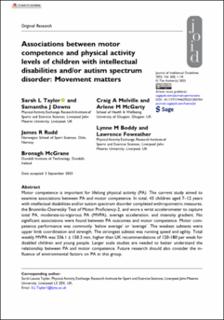| dc.contributor.author | Taylor, Sarah L. | |
| dc.contributor.author | Downs, Samantha J. | |
| dc.contributor.author | Rudd, James Robert | |
| dc.contributor.author | McGrane, Bronagh | |
| dc.contributor.author | Melville, Craig A. | |
| dc.contributor.author | McGarty, Arlene M. | |
| dc.contributor.author | Boddy, Lynne M. | |
| dc.contributor.author | Foweather, Lawrence | |
| dc.date.accessioned | 2024-01-04T16:38:24Z | |
| dc.date.available | 2024-01-04T16:38:24Z | |
| dc.date.created | 2023-10-05T10:53:44Z | |
| dc.date.issued | 2023 | |
| dc.identifier.citation | Journal of Intellectual Disabilities. 2023, Artikkel 17446295231203764. | en_US |
| dc.identifier.issn | 1744-6295 | |
| dc.identifier.uri | https://hdl.handle.net/11250/3109910 | |
| dc.description | This article is distributed under the terms of the Creative Commons Attribution 4.0 License (https://creativecommons.org/licenses/by/4.0/) which permits any use, reproduction and distribution of the work without further permission provided the original work is attributed as specified on the SAGE and Open Access page (https://us.sagepub.com/en-us/nam/open-access-at-sage). | en_US |
| dc.description.abstract | Motor competence is important for lifelong physical activity (PA). The current study aimed to examine associations between PA and motor competence. In total, 43 children aged 7–12 years with intellectual disabilities and/or autism spectrum disorder completed anthropometric measures, the Bruininks-Oseretsky Test of Motor Proficiency-2, and wore a wrist accelerometer to capture total PA, moderate-to-vigorous PA (MVPA), average acceleration, and intensity gradient. No significant associations were found between PA outcomes and motor competence. Motor competence performance was commonly ‘below average’ or ‘average’. The weakest subtests were upper limb coordination and strength. The strongest subtest was running speed and agility. Total weekly MVPA was 336.1 ± 150.3 min, higher than UK recommendations of 120-180 per week for disabled children and young people. Larger scale studies are needed to better understand the relationship between PA and motor competence. Future research should also consider the influence of environmental factors on PA in this group. | en_US |
| dc.language.iso | eng | en_US |
| dc.subject | autism spectrum disorder | en_US |
| dc.subject | children | en_US |
| dc.subject | intellectual disability | en_US |
| dc.subject | motor competence | en_US |
| dc.subject | physical activity | en_US |
| dc.title | Associations between motor competence and physical activity levels of children with intellectual disabilities and/or autism spectrum disorder: Movement matters | en_US |
| dc.type | Peer reviewed | en_US |
| dc.type | Journal article | en_US |
| dc.description.version | publishedVersion | en_US |
| dc.rights.holder | © The Author(s) 2023 | en_US |
| dc.source.pagenumber | 18 | en_US |
| dc.source.journal | Journal of Intellectual Disabilities | en_US |
| dc.identifier.doi | 10.1177/17446295231203764 | |
| dc.identifier.cristin | 2181952 | |
| dc.description.localcode | Institutt for lærerutdanning og friluftslivsstudier / Department of Teacher Education and Outdoor Studies | en_US |
| dc.source.articlenumber | 17446295231203764 | en_US |
| cristin.ispublished | true | |
| cristin.fulltext | original | |
| cristin.qualitycode | 1 | |
